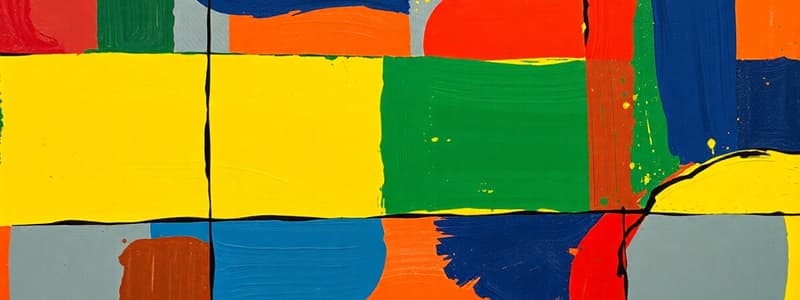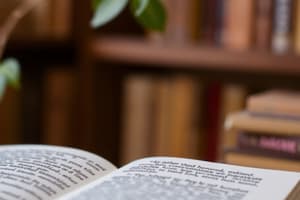Podcast
Questions and Answers
What technique involves comparing two unlike things without using 'as' or 'like'?
What technique involves comparing two unlike things without using 'as' or 'like'?
- Personification
- Simile
- Metaphor (correct)
- Alliteration
Which stylistic device describes non-human entities with human qualities?
Which stylistic device describes non-human entities with human qualities?
- Imagery
- Personification (correct)
- Metaphor
- Repetition
Which example correctly illustrates the use of metaphor?
Which example correctly illustrates the use of metaphor?
- He fought like a lion.
- Time is a thief. (correct)
- The wind whispered through the trees.
- Her smile was as bright as the sun.
In the phrase 'Love's not Time's fool', what stylistic device is predominantly used?
In the phrase 'Love's not Time's fool', what stylistic device is predominantly used?
Which of the following is NOT considered a stylistic device?
Which of the following is NOT considered a stylistic device?
What term best describes the repetition of the same initial consonant sounds in a series of words?
What term best describes the repetition of the same initial consonant sounds in a series of words?
Which of the following phrases demonstrates the use of a simile?
Which of the following phrases demonstrates the use of a simile?
What is the primary purpose of using hyperbole in writing?
What is the primary purpose of using hyperbole in writing?
How does irony differ from straightforward criticism?
How does irony differ from straightforward criticism?
Which of the following best describes the function of a rhetorical question?
Which of the following best describes the function of a rhetorical question?
What is the significance of juxtaposition in literary works?
What is the significance of juxtaposition in literary works?
What term is used to describe a text that uses irony to ridicule
What term is used to describe a text that uses irony to ridicule
What is the primary function of anaphora in writing?
What is the primary function of anaphora in writing?
Which of the following best describes enjambement?
Which of the following best describes enjambement?
In the context of enumeration, which of the following is true?
In the context of enumeration, which of the following is true?
Which literary device uses repeating words or phrases at the beginning of clauses?
Which literary device uses repeating words or phrases at the beginning of clauses?
Which option does NOT characterize enjambement?
Which option does NOT characterize enjambement?
What role does enumeration play in argumentative texts?
What role does enumeration play in argumentative texts?
Which of the following is an example of enjambement?
Which of the following is an example of enjambement?
In anaphora, which of the following is not typically a desired effect?
In anaphora, which of the following is not typically a desired effect?
What is the effect of using enumeration in writing?
What is the effect of using enumeration in writing?
What literary device is used in 'Anthem for doomed youth' to imitate rifle shots?
What literary device is used in 'Anthem for doomed youth' to imitate rifle shots?
What is the main purpose of accumulation in writing?
What is the main purpose of accumulation in writing?
In which work does the character Juliet express an analogy about the nature of names?
In which work does the character Juliet express an analogy about the nature of names?
What does the listing of names in the excerpt from 'Henry V' primarily serve to achieve?
What does the listing of names in the excerpt from 'Henry V' primarily serve to achieve?
Which of the following best describes the purpose of an analogy?
Which of the following best describes the purpose of an analogy?
In poetic terms, what does the phrase 'freshly remembered' imply about the names listed?
In poetic terms, what does the phrase 'freshly remembered' imply about the names listed?
Which sound device is NOT used in the analysis of 'Anthem for doomed youth'?
Which sound device is NOT used in the analysis of 'Anthem for doomed youth'?
What thematic element is highlighted through Juliet's words about a rose?
What thematic element is highlighted through Juliet's words about a rose?
What emotion is primarily evoked through the repetition in 'Anthem for doomed youth'?
What emotion is primarily evoked through the repetition in 'Anthem for doomed youth'?
What is the primary purpose of parallelism in writing?
What is the primary purpose of parallelism in writing?
How does repetition function in a text?
How does repetition function in a text?
Which of the following correctly defines allusion?
Which of the following correctly defines allusion?
What can the term cliche imply about a phrase's usage?
What can the term cliche imply about a phrase's usage?
In the context of parallelism, what effect does placing the most important element at the end of a sequence have?
In the context of parallelism, what effect does placing the most important element at the end of a sequence have?
Which literary device involves a reference to the 'garden of Eden'?
Which literary device involves a reference to the 'garden of Eden'?
When is repetition most effective in writing?
When is repetition most effective in writing?
What type of structure does parallelism often employ?
What type of structure does parallelism often employ?
Which of the following statements about allusion is correct?
Which of the following statements about allusion is correct?
What characterizes a cliche in writing?
What characterizes a cliche in writing?
Flashcards
Stylistic Device
Stylistic Device
A method or technique used to create a specific effect in writing.
Metaphor
Metaphor
A comparison between two unlike things without using "like" or "as".
Personification
Personification
Giving human qualities to animals, objects, or ideas.
Simile
Simile
Signup and view all the flashcards
Alliteration
Alliteration
Signup and view all the flashcards
Repetition
Repetition
Signup and view all the flashcards
Imagery
Imagery
Signup and view all the flashcards
Anaphora
Anaphora
Signup and view all the flashcards
Enjambement
Enjambement
Signup and view all the flashcards
Enumeration
Enumeration
Signup and view all the flashcards
Parallelism
Parallelism
Signup and view all the flashcards
Syntax
Syntax
Signup and view all the flashcards
Accumulation
Accumulation
Signup and view all the flashcards
Analogy
Analogy
Signup and view all the flashcards
Sound Imagery
Sound Imagery
Signup and view all the flashcards
Movement Imagery
Movement Imagery
Signup and view all the flashcards
How does sound imagery work?
How does sound imagery work?
Signup and view all the flashcards
How does movement imagery work?
How does movement imagery work?
Signup and view all the flashcards
Example of Accumulation
Example of Accumulation
Signup and view all the flashcards
Example of Analogy
Example of Analogy
Signup and view all the flashcards
Example of Sound Imagery
Example of Sound Imagery
Signup and view all the flashcards
Exaggeration
Exaggeration
Signup and view all the flashcards
Hyperbole
Hyperbole
Signup and view all the flashcards
Irony
Irony
Signup and view all the flashcards
Juxtaposition
Juxtaposition
Signup and view all the flashcards
Rhetorical question
Rhetorical question
Signup and view all the flashcards
Allusion
Allusion
Signup and view all the flashcards
What does an allusion do?
What does an allusion do?
Signup and view all the flashcards
Cliché
Cliché
Signup and view all the flashcards
What does a cliché do?
What does a cliché do?
Signup and view all the flashcards
Study Notes
Stylistic Devices
- Stylistic devices are methods and techniques used to create a specific effect. They can relate to sound (like alliteration), structure (repetition, parallelism), or imagery.
- Metaphor: A comparison between dissimilar things without using "like" or "as". A metaphor states that one thing is another.
- Personification: Representing animals or objects as if they were human beings or had human qualities.
- Simile: A comparison between dissimilar things using "like" or "as." A simile says that one thing is like another.
- Alliteration: Repetition of a sound, usually a consonant, at the beginning of words.
- Assonance: Repetition of vowel sounds within stressed syllables of words.
- Onomatopoeia: Words that imitate sounds.
- Accumulation: A list of words or expressions with similar meanings.
- Analogy: Comparing two things that are similar in several ways, making an explanation simpler.
- Anaphora: Repetition of a word or phrase at the beginning of clauses.
- Enjambement: Incomplete syntax at the end of a line, where the meaning continues to the next line without punctuation.
- Enumeration: Listing words, phrases, or ideas.
- Parallelism: Using similar or identical words, phrases, etc.,in neighboring sentences to highlight ideas.
- Repetition: Repeating a word or phrase for emphasis or style.
- Allusion: Reference to something well-known like literature, history, or religion.
- Cliché: Overused expression that loses its original meaning.
- Exaggeration (Hyperbole): A strong overstatement for effect or humor.
- Irony: Using words to mean the opposite of what is literally said.
- Juxtaposition: Placing contrasting ideas, words, or situations next to each other for emphasis.
- Rhetorical Question: A question designed to make a point rather than to elicit an answer.
- Understatement: Minimizing the significance of something for effect.
- Wordplay/Pun: Using words with multiple meanings to create humor.
Studying That Suits You
Use AI to generate personalized quizzes and flashcards to suit your learning preferences.




